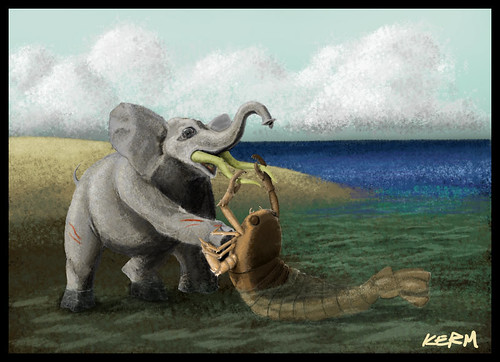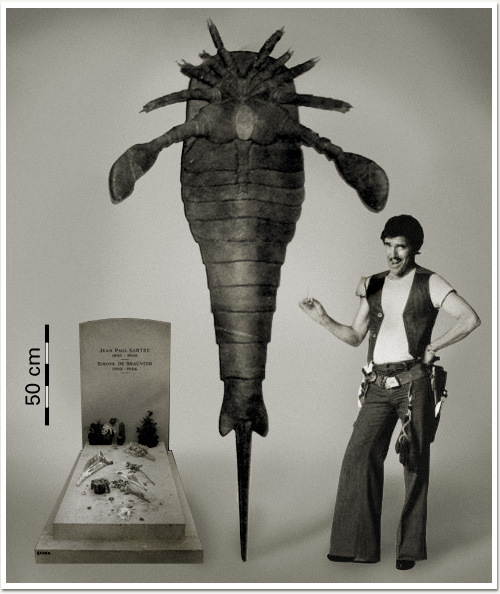 On 20.11.2007 scientists who discovered the fossil claw of a giant sea scorpion in southern Germany say the find -- the biggest of its kind -- suggests similar ancient creatures were much larger than previously thought.
On 20.11.2007 scientists who discovered the fossil claw of a giant sea scorpion in southern Germany say the find -- the biggest of its kind -- suggests similar ancient creatures were much larger than previously thought.German palaeontologist Markus Poschmann excavated the fossilized claw of the giant aquatic creature from 390 million-year-old rocks near the town of Prüm in Rhineland Palatinate, the online journal Biology Letters reported on Tuesday, Nov. 20.
The 46-centimeter (18-inch) claw probably came from an animal around 2.5 meters (eight feet, two inches) in length -- half a meter longer than any previously found.
"This is an amazing discovery," said Simon Braddy from the Department of Earth Sciences at the University of Bristol in England, in a press release.
Braddy, along with Poschmann from the General Department of Cultural Heritage in Rhineland-Palatinate and Erik Tetlie from Yale University, co-authored the report.
Scientists surprised at size of find
 "We have known for some time that the fossil record yields monster millipedes, super-sized scorpions, colossal cockroaches, and jumbo dragonflies, but we never realized, until now, just how big some of these ancient creepy-crawlies were," Braddy added.
"We have known for some time that the fossil record yields monster millipedes, super-sized scorpions, colossal cockroaches, and jumbo dragonflies, but we never realized, until now, just how big some of these ancient creepy-crawlies were," Braddy added.Poschmann described finding the claw in an area that probably had once been an ancient estuary or swamp.
"I was loosening pieces of rock with a hammer and chisel when I suddenly realized there was a dark patch of organic matter on a freshly removed slab. After some cleaning I could identify this as a small part of a large claw," Poschmann said.
"Although I didn't know if it was complete or not, I decided to try and get it out. The pieces had to be cleaned separately, dried, and then glued back together. It was then put into a white plaster jacket to stabilize it," he said.
Theories vary on reason for monstrous size
 The article said the discovery of the 390-million-year-old giant fossil claw proved that arthropods (spiders, insects and crabs with segmented bodies, jointed limbs and a hard external skeleton) were much larger in the past than previously thought.
The article said the discovery of the 390-million-year-old giant fossil claw proved that arthropods (spiders, insects and crabs with segmented bodies, jointed limbs and a hard external skeleton) were much larger in the past than previously thought.Biologists delving into the earth's distant past are divided as to how some arthropods were able to develop to such monstrous sizes. Some suggest that they benefited from an oxygen-rich atmosphere, while others argue that they had to get bigger in order to keep up with the supersizing of their likely prey, the early armored fish.
"There is no simple single explanation," Braddy said.
"It is more likely that some ancient arthropods were big because there was little competition from the vertebrates, as we see today. If the amount of oxygen in the atmosphere suddenly increased, it doesn't mean all the bugs would get bigger."
Species only found in present-day Germany
 Despite their name, sea scorpions -- known as eurypterids -- were not true scorpions. Equipped with long, flat, jointed carapaces, they stalked warm shallow sea waters from around 500 million to 250 million years ago, eventually moving into fresh water.
Despite their name, sea scorpions -- known as eurypterids -- were not true scorpions. Equipped with long, flat, jointed carapaces, they stalked warm shallow sea waters from around 500 million to 250 million years ago, eventually moving into fresh water.Eurypterids are believed to be the extinct aquatic ancestors of today's scorpions and possibly all arachnids, a class of joint-legged, invertebrate animals, including spiders, scorpions, mites and ticks.
Braddy said the fossil was from a Jaekelopterus Rhenaniae, a kind of scorpion that lived only in Germany for about 10 million years, about 400 million years ago.
No comments:
Post a Comment